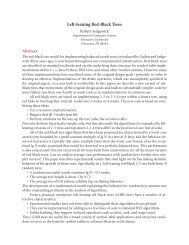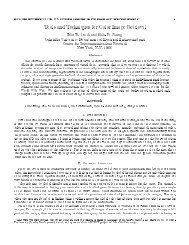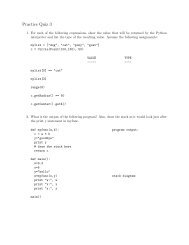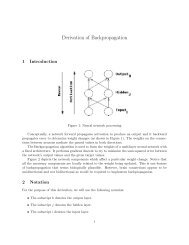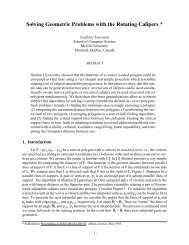Finding Musically Meaningful Words by Sparse CCA
Finding Musically Meaningful Words by Sparse CCA
Finding Musically Meaningful Words by Sparse CCA
You also want an ePaper? Increase the reach of your titles
YUMPU automatically turns print PDFs into web optimized ePapers that Google loves.
category. In both cases, a vocabulary required manual construction and included some noisy wordsthat degraded the performance of our computer audition system.Presumably, one reason that certain words cause problems for our system is that the acoustic representationof these words is hard to model. This relates to the expressive power of our chosenaudio feature representation. For example, if we are interested in words related to long-term musicstructure (e.g., ‘12-bar blues’) and we only represent the audio using short-term ( < 1 sec) audiofeature vectors, we may be unable to model such concepts. Another example is words that relateto a geographical association (e.g., ‘British Invasion’, ‘Woodstock’) which may have strong culturalroots, but are poorly represented in the audio content.In this paper and in our latest research [15], given an audio feature representation, we wish toidentify words that are represented well <strong>by</strong> the audio content before we try to model them. Todo this we propose the use of an unsupervised method based on canonical correlation analysis(<strong>CCA</strong>) to measure acoustic correlation. <strong>CCA</strong> is a method of exploring correlations between differentrepresentations of some underlying data where these representations exist in two different featurespaces (vector spaces). For example, in this paper the information we wish to model, the semanticsof music, is represented as text labels and audio features. <strong>CCA</strong> has also been used in applicationsdealing with multi-language text analysis [19], learning semantic representations between imagesand text [2], and localizing pixels which are correlated with audio in a video stream [6]. Similarto the way principal component analysis (PCA) finds informative vectors in one feature space <strong>by</strong>maximizing the variance of projected data, <strong>CCA</strong> finds pairs of vectors within two feature spacesthat maximize correlation. Put another way, <strong>CCA</strong> finds a one dimensional subspace within eachfeature space such that the projection of data points onto their respective subspaces maximizes thecorrelation between these one-dimensional projections.Given music data represented in both a semantic feature space and an acoustic feature space, wepropose that these vectors of maximal correlation can be used to find words that are strongly characterized<strong>by</strong> an audio representation. Specifically, the <strong>CCA</strong> solution vector, or canonical component,that corresponds to the semantic representation is a mapping of vocabulary words to weights wherea high weight implies that a given word is highly correlated with the audio feature representation.We interpret high weights as singling out words that are “musically meaningful”. In other words,the underlying relationship (a correlation) between word and audio feature representation hints thata word may be more accurately modeled than a word for which no such relationship exists.Generally <strong>CCA</strong> returns a mapping of words to weights that is non-sparse, meaning that each wordwill be mapped to a non-zero weight. Hence, selecting good words from this vocabulary would bedone <strong>by</strong> thresholding the weights or <strong>by</strong> some other similar heuristic. It is desirable to remove suchan arbitrary step from the vocabulary selection process. This is done <strong>by</strong> imposing sparsity on thesolution weights, that is, we modify the <strong>CCA</strong> problem so that it tends to give solutions with few nonzeroweights, (sparse <strong>CCA</strong> [13]). This leads to a very natural criterion for selecting a vocabulary:throw away words with weights equal to zero.2 Acoustic Correlation with <strong>CCA</strong>Canonical Correlation Analysis, or <strong>CCA</strong>, is a method of exploring dependencies between data whichare represented in two different, but related, feature spaces. For example, consider a set of songswhere each song is represented <strong>by</strong> both a semantic annotation vector and an audio feature vector.An annotation vector for a song is a real-valued (or binary) vector where each element represents thestrength of association between the song and a word from our vocabulary. An audio feature vectoris a real-valued vector of statistics calculated from the digital audio signal. It is assumed that thetwo spaces share some joint information which can be captured in the form of correlations betweenthe data in the two feature spaces. <strong>CCA</strong> finds a one-dimensional projection of the data in each spacesuch that the correlations between the projections is maximized.More formally, consider two data matrices, A and S, from two different feature spaces. The rowsof A contain music data represented in the audio feature space A. The corresponding rows of Scontain the music data represented in the semantic annotation space S (e.g., annotation vectors).<strong>CCA</strong> seeks to optimizemaxw {wT a Σ as w s : wa T Σ aa w a = 1, ws T Σ ss w s = 1} (1)a∈A,w s∈S2



